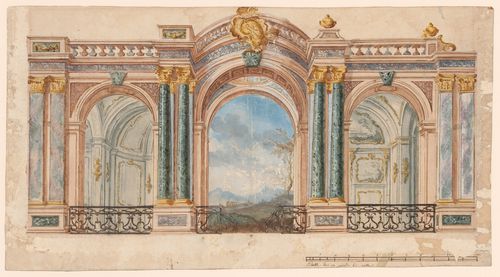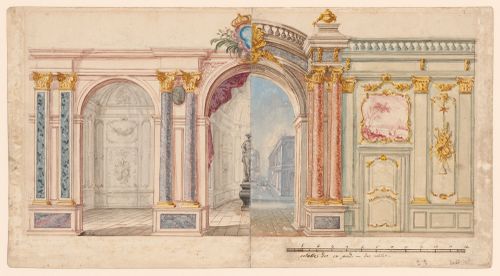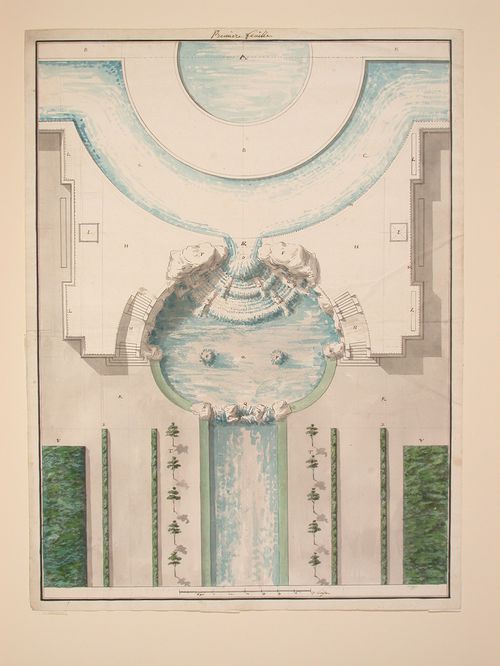Project
AP140.S2.SS1.D41
Description:
File documents an unexecuted project for an arts centre, an addition to existing 18th-century house and lodges for the University of St. Andrews, Scotland, United Kingdom. Material in this file was produced between 1971 and 1974. File contains design development drawings, several presentation drawings and working drawings. Photographic materials include views of drawings as well as views of a model by John Donat Photography. File also contains textual records.
1971-1974
Arts Centre, University of St. Andrews, St. Andrews, England, United Kingdom
Actions:
AP140.S2.SS1.D41
Description:
File documents an unexecuted project for an arts centre, an addition to existing 18th-century house and lodges for the University of St. Andrews, Scotland, United Kingdom. Material in this file was produced between 1971 and 1974. File contains design development drawings, several presentation drawings and working drawings. Photographic materials include views of drawings as well as views of a model by John Donat Photography. File also contains textual records.
File 41
1971-1974
artefacts
artefacts
18th century
artefacts
artefacts
artefacts
DR1967:0010:001
Description:
- The two halves of this drawing show alternate stage sets from which the patron could make his choice. It is unclear whether this design was for a painted trompe-l'oeil stage backdrop and/or a constructed stage set. The deep unified space of the architectural interior and low vanishing point of the central landscape indicates that this part of the drawing is probably intended to be a painted trompe-l'oeil, however, the inscribed scale suggests that some of the architectural elements may have been constructed (Fuhring, 161 and 570). The prickings indicate that the overall design was intended to be executed. A crown above the central cartouche in drawing DR1967:0010:002 which is probably by the same hand, indicates a possible royal connection.
theatre design, interior design
probably between 1745-1775
Presentation drawing for a stage set with a central trompe-l'oeil landscape
Actions:
DR1967:0010:001
Description:
- The two halves of this drawing show alternate stage sets from which the patron could make his choice. It is unclear whether this design was for a painted trompe-l'oeil stage backdrop and/or a constructed stage set. The deep unified space of the architectural interior and low vanishing point of the central landscape indicates that this part of the drawing is probably intended to be a painted trompe-l'oeil, however, the inscribed scale suggests that some of the architectural elements may have been constructed (Fuhring, 161 and 570). The prickings indicate that the overall design was intended to be executed. A crown above the central cartouche in drawing DR1967:0010:002 which is probably by the same hand, indicates a possible royal connection.
theatre design, interior design
DR1967:0010:002
Description:
- The two halves of this drawing show alternate stage sets from which the patron could make his choice. It is unclear whether this design was for a painted trompe-l'oeil stage backdrop and/or a constructed stage set. The deep unified space and low vanishing point of the central piazza/hemicycle interior indicates that this section is probably a painted trompe-l'oeil, however, the curtain pulled back within the central arch and the inscribed scale suggest that some of the architectural elements may have been constructed (Fuhring, 161 and 570). An etching of the Hermes is laid down on the left variant of the central portion of the drawing. The prickings indicate that the overall design was intended to be executed, and the crown above the central cartouche indicates a possible royal connection.
theatre design
probably between 1745-1775
Presentation drawing for a stage set with alternate designs
Actions:
DR1967:0010:002
Description:
- The two halves of this drawing show alternate stage sets from which the patron could make his choice. It is unclear whether this design was for a painted trompe-l'oeil stage backdrop and/or a constructed stage set. The deep unified space and low vanishing point of the central piazza/hemicycle interior indicates that this section is probably a painted trompe-l'oeil, however, the curtain pulled back within the central arch and the inscribed scale suggest that some of the architectural elements may have been constructed (Fuhring, 161 and 570). An etching of the Hermes is laid down on the left variant of the central portion of the drawing. The prickings indicate that the overall design was intended to be executed, and the crown above the central cartouche indicates a possible royal connection.
theatre design
DR1985:0361
Description:
- Ce plan à l'échelle montre un bassin avec cascade en forme de coquillage, d'où jaillissent deux jets d'eau.
landscape architecture
ca. 1760
Design for a basin with a cascade
Actions:
DR1985:0361
Description:
- Ce plan à l'échelle montre un bassin avec cascade en forme de coquillage, d'où jaillissent deux jets d'eau.
landscape architecture
drawings
DR1985:0360
Description:
- Le plan principal montre le site d'un château ainsi que l'aménagement de son jardin. L'ensemble témoigne des époques successives: le bâtiment lui-même, constitué d'un corps de logis et de deux ailes, forme un carré flanqué d'une tourelle à chaque angle et est ceinturé par un fossé rempli d'eau, rappelant l'ancien château féodal. Une loggia typiquement renaissance borde le corps principal du côté de la cour intérieure. Le jardin quand à lui présente successivement des parterres en broderie qui nous ramènent au tournant du 17ème siècle, puis un bassin avec fontaine et des cabinets verts séparés au centre par un canal, éléments caractéristiques du jardin français classique du 17ème siècle. C'est dans cette dernière partie, entre le bassin avec fontaine et le canal séparant les cabinets verts, qu'une proposition de modification est présentée sous la forme d'un rabat abaissé sur le dessin principal. Datant du 18ème siècle, ce dessin propose l'aménagement d'un bassin avec cascade en forme de coquillage à la tête du canal. Finalement, une esquisse à l'encre rouge se superpose au dessin du rabat pour une deuxième modification du projet.
landscape architecture
ca. 1760
Design for a basin with a cascade in the garden of a château
Actions:
DR1985:0360
Description:
- Le plan principal montre le site d'un château ainsi que l'aménagement de son jardin. L'ensemble témoigne des époques successives: le bâtiment lui-même, constitué d'un corps de logis et de deux ailes, forme un carré flanqué d'une tourelle à chaque angle et est ceinturé par un fossé rempli d'eau, rappelant l'ancien château féodal. Une loggia typiquement renaissance borde le corps principal du côté de la cour intérieure. Le jardin quand à lui présente successivement des parterres en broderie qui nous ramènent au tournant du 17ème siècle, puis un bassin avec fontaine et des cabinets verts séparés au centre par un canal, éléments caractéristiques du jardin français classique du 17ème siècle. C'est dans cette dernière partie, entre le bassin avec fontaine et le canal séparant les cabinets verts, qu'une proposition de modification est présentée sous la forme d'un rabat abaissé sur le dessin principal. Datant du 18ème siècle, ce dessin propose l'aménagement d'un bassin avec cascade en forme de coquillage à la tête du canal. Finalement, une esquisse à l'encre rouge se superpose au dessin du rabat pour une deuxième modification du projet.
drawings
ca. 1760
landscape architecture
archives
Level of archival description:
Collection
Rohault de Fleury collection
CI001
Synopsis:
The Rohault de Fleury collection documents the work of three generations of French architects, Hubert, his son Charles, and his grandson Georges, spanning from the early 18th to late 19th century. The collection is extremely varied encompassing both private and government commissions and including domestic work, institutional buildings, commercial buildings, urban planning, and student work from both the École des beaux-arts and the École polytechnique, and archaeological studies. Stylistically, the projects incorporate the two dominant contemporary directions in French architecture - functionalism as advocated by Jean-Nicolas-Louis Durand and the classicism of the École des beaux-arts.
1717-[1884]
Rohault de Fleury collection
CI001
Synopsis:
The Rohault de Fleury collection documents the work of three generations of French architects, Hubert, his son Charles, and his grandson Georges, spanning from the early 18th to late 19th century. The collection is extremely varied encompassing both private and government commissions and including domestic work, institutional buildings, commercial buildings, urban planning, and student work from both the École des beaux-arts and the École polytechnique, and archaeological studies. Stylistically, the projects incorporate the two dominant contemporary directions in French architecture - functionalism as advocated by Jean-Nicolas-Louis Durand and the classicism of the École des beaux-arts.
archives
Level of archival description:
Collection 1
1717-[1884]


